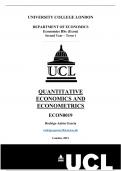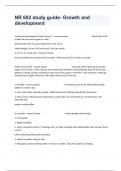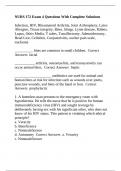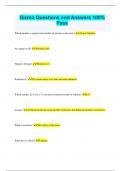UNIVERSITY COLLEGE LONDON
DEPARTMENT OF ECONOMICS
Economics BSc (Econ)
Second Year – Term 1
QUANTITATIVE
ECONOMICS AND
ECONOMETRICS
ECON0019
Rodrigo Antón García
rodrigo.garcia.20@ucl.ac.uk
London, 2021
,
, Contents
Topic 0 – Introduction. Wooldridge Chapter 1.
o What is Econometrics? 1
o Steps in Empirical Economic Analysis. 1
o The Structure of Economic Data. 2
o Correlation, Causality, Ceteris Paribus and Counterfactual Reasoning. 3
Topic 1 – Simple Linear Regression (SLR). Wooldridge Chapter 2.
o Simple Linear Regression Model (SLR). 6
o Ordinary Least Squares Estimator (OLS) in SLR. 8
o The Four Main OLS Assumptions in SLR. 11
o Desirable Properties of Estimators in SLR. 13
o Further OLS Assumptions in SLR. 15
o Variance of OLS Estimator in SLR. 15
2
o Goodness-of-Fit (R ) in SLR. 17
o Simple Linear Regression Lecture Notes (Part I). 19
Topic 2 – Multiple Linear Regression (MLR). Wooldridge Chapter 3.
o Motivation for Multiple Linear Regression (MLR). 31
o Mechanics and Interpretation of OLS in MLR (! = 2). 32
o Functional Forms in MLR. 37
o The Four Main OLS Assumptions in MLR. 39
o Desirable Properties of Estimators in MLR. 43
o Further OLS Assumptions in MLR. 45
o Variance of OLS Estimator in MLR. 45
o Efficiency of OLS: The Gauss-Markov Theorem. 47
o Multiple Linear Regression Lecture Notes (Part II). 48
,Topic 3 – Finite Sample Inference in MLR. Wooldridge Chapter 4.
o Sampling Distributions of the OLS Estimators. 55
o Sampling Distribution of t-statistics. 56
o Testing Hypothesis About a Single Population Parameter: The t Test. 57
o Confidence Intervals. 60
o Testing Hypotheses About a Single Linear Combination of the Param. 61
o Testing Multiple Linear Restrictions: The F Test. 63
Topic 4 – Large-Sample Inference in MLR. Wooldridge Chapter 5.
o Consistency. 67
o Asymptotic Normality of OLS. 70
o Asymptotic Theory of OLS Lecture Notes (Part III). 72
Topic 5 – MLR: Further Issues. Wooldridge Chapter 6.
o Effects of Data Scaling: Changing Units of Measurement. 77
o More on Functional Forms: Logarithmic, Quadratic and Interaction Term.77
o More on Goodness-of-Fit and Selection of Regressors. 82
o Prediction and Residual Analysis. 85
Topic 6 – MLR with Qualitative Information. Wooldridge Chapter 7.
o Describing Qualitative Information. 88
o A Single Dummy Independent Variable. 88
o Using Dummy Variables for Multiple Categories. 89
o Incorporating Ordinal Information by Using Dummy Variables. 91
o Interactions Involving Dummy Variables. 94
o The Chow Test: Testing Models with Dummy Variables Interactions. 95
o The Linear Probability Model: Dependent Variable is a Dummy Variable. 98
,Topic 7 – Heteroskedasticity. Wooldridge Chapter 8.
o Consequences of Heteroskedasticity for OLS. 104
o Heteroskedasticity-Robust (HR) Interference after OLS Estimation. 105
o Testing for Heteroskedasticity: Breusch-Pagan Test. 110
o Generalised/Weighted Least Squared Estimators GLS (WLS). 113
o Heteroskedasticity Lecture Notes (Part IV). 114
Topic 8 – More on Specification and Data Issues. Wooldridge Chapter 9.
o Proxy Variables. 117
o Measurement Errors. 120
o Non-Random Sampling and Missing Data. 124
o Outlying Observations. 125
o Least Absolute Derivations (LAD) Estimators. 129
o Quantile Regression. 133
Topic 9 – Pooled Regressions and Panel Data Methods I. Wooldridge Chapter 13.
o Combinations of Cross-Sectional and Time Series Data. 135
o Pooled (Repeated) Cross Regressions. 135
o Policy Analysis with Pooled Data. 140
o Differences in Differences (Dif-in-Dif, DiD) Estimator. 141
o Panel Data Methods I. 145
o First-Differencing Estimator (FD). 147
Topic 10 – Panel Data Methods II. Wooldridge Chapter 14.
o Inference of OLS with Panel Data: The Role of Autocorrelation. 149
o Clustered Standard Errors. 150
o Panel Data Model with Autocorrelated Errors. 150
o Fixed Effects (or Within) Estimator (FE). 152
o Random Effects Estimator (RE). 154
o Testing for FE or RE: Hausman Test. 156
o Repeated Cross Sections and Panel Data Notes (Part V). 157
,
,ECON0019 – Quantitative Economics and Econometrics Rodrigo Antón García
ECON0019: QUANTITATIVE ECONOMICS AND ECONOMETRICS – TERM 1
Topic 0 – Introduction. Wooldridge Chapter 1.
• What Is Econometrics?
Econometrics is the set of tools by which economists, and others in the social sciences,
analyze data. We can use econometrics to estimate economic relationships, test
economic theories, and evaluate government and business policy. Overall, econometrics
focuses on problems inherent in analyzing data generated by individuals, firms, and
other entities acting strategically, and interacting with one another.
Experimental data, data from controlled experiments, while common in the natural
sciences, is harder to come by in the social sciences (although some exist). Therefore,
we have to access non-experimental data, which are sometimes called observational or
retrospective data.
Such data sets are collected in a passive manner, after we observe outcomes on
individuals, firms, etc. Econometricians act as observers of what has happened and then
try to learn from what they observe.
• Steps in Empirical Economic Analysis.
- Step 1. Carefully pose the questions. Be very precise in posing the question you
hope to answer. For example, does attending lectures lead to better grades (on average)?
- Step 2. Specify an economic model, or at least a conceptual model, to study the
phenomenon of interest. Formal economic modeling (such as utility maximizaton) is
often used, but one can get by with careful economic reasoning that is less formal.
Example. To study the effects of job training on worker productivity, where productivity
is measured by observed hourly wage, we could build an economic model describing
how wages are set. We could start by simply setting an equation such as
!"#$ = ' ($)*+, $-.$/, 0/"1212#)
where $)*+ is a measure of schooling, $-.$/ is a measure of workforce experience, and
0/"1212# is a measure of time spent in job training (the variable of most interest).
- Step 3. Turn the economic model into an econometric model. How should we
measure the outcome of interest? What is the exact functional relationship among the
economic variables? How do we account for unobserved factors that make relationships
among variables inexact?
We can specify an econometric model for the wage/job training example as
!"#$ = 4! + 4" $)*+ + 4# $-.$/ + 4$ 0/"1212# + *
1
, ECON0019 – Quantitative Economics and Econometrics Rodrigo Antón García
The constants 4! , 4" , 4# , and 4$ are the parameters of the model, and it is these
(especially 4$ in this example) that we hope to estimate. Ideally, we will be able to collect
data on !"#$, $)*+, $-.$/, and 0/"1212# from a large group of working people.
The last term * is called the error term or disturbance. It represents all other factors that
can affect someone’s wage, including native intelligence, motivation and so on. The error
term can also capture measurement problems in one or more of the variables.
We will want to use data and statistical methods, to estimate and test hypotheses about
the parameters. For example, the hypothesis that job training has no effect on wage is
4$ = 0, and for one year of experience being worth one year of education is 4" = 4# .
- Step 4. Collect data on the variables and use statistical methods to estimate the
parameters, construct confidence intervals for the parameters, and test hypotheses.
Economic data come in several different forms such as cross-sectional, time series data,
pooled cross sections and panel data structures.
• The Structure of Economic Data.
Datasets are collections of realisations of random variables. They usually include several
variables X, Y, Z, etc., and there is a value for these variables for each of the N
observations in the dataset. Each observation is a realization of the random variable: (X1,
X2, ..., XN), (Y1, Y2, ..., YN), (Z1, Z2, ..., ZN), etc.
Data differ by their unit of observation (or level): individual person, household, firms, etc.
or for example aggregated at geographical areas, e.g., countries.
- Cross-Sectional Data.
A cross-sectional data set consists of a sample of individuals, households, firms, cities,
states, countries, or a variety of other units of interest, taken at a given point in time.
These data are good for investigating relationships between variables which vary across
in units at a given point in time (incomes, commodity demands).
An important feature of cross-sectional data is that we can often assume that they have
been obtained by random sampling from the underlying population. Random sampling
(with replacement) generates observations that are statistically independent of one
another and identically distributed, having the same chance of appearing in the sample
(i.i.d.).
A feature of many cross-sectional data sets, is that the ordering of the individuals is
arbitrary and unimportant; it is irrelevant whom we label observation 1, or observation 2
to. We call these sets where nothing would be lost be randomly rearranging the order of
the individual’s observational sets. Some cross-sectional data sets are experimental,
where we assign individuals (or units) to treatment and control groups. However,
experimental data sets are relatively rare in the social sciences.
2







